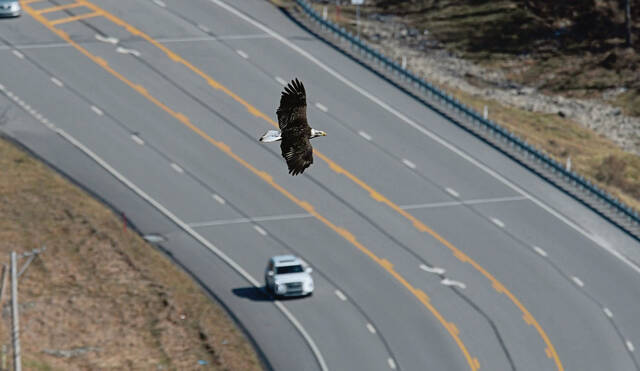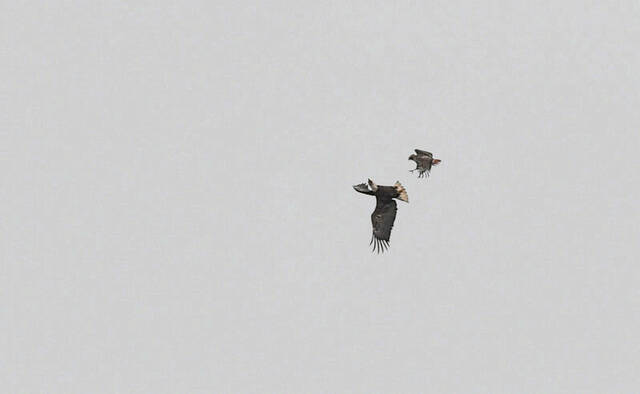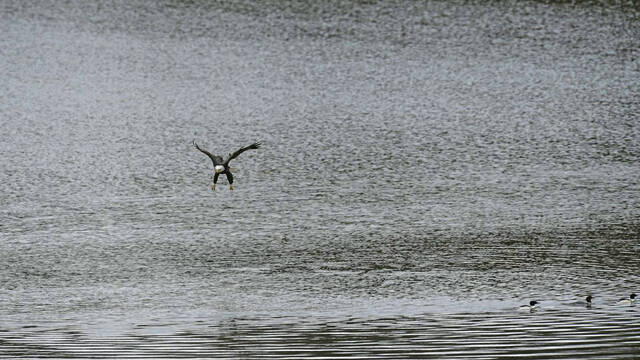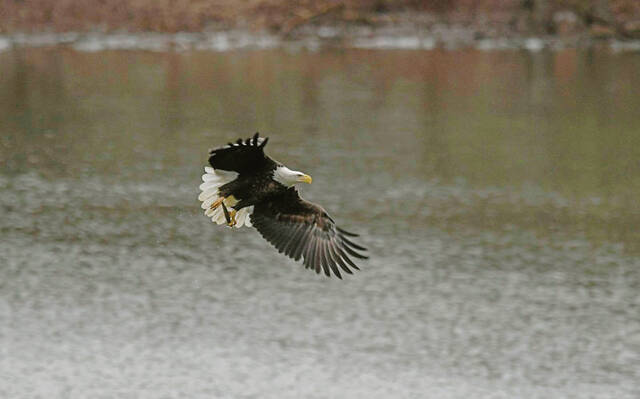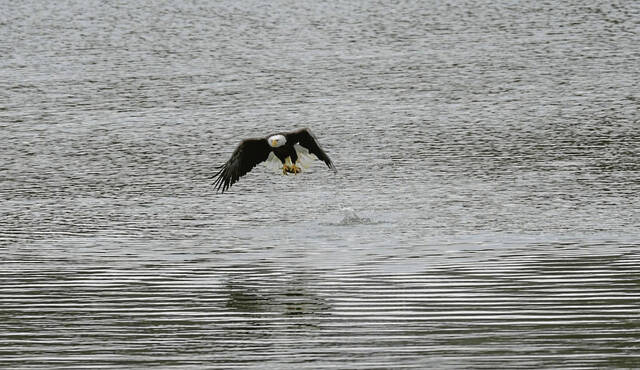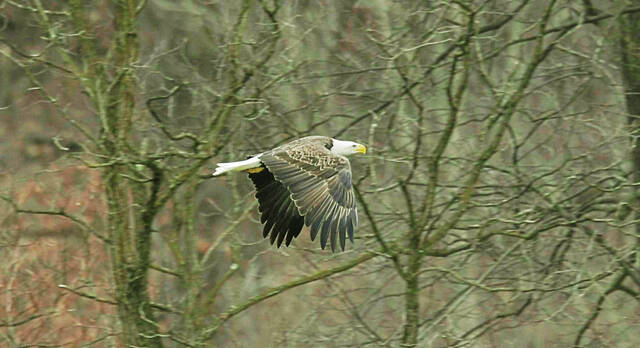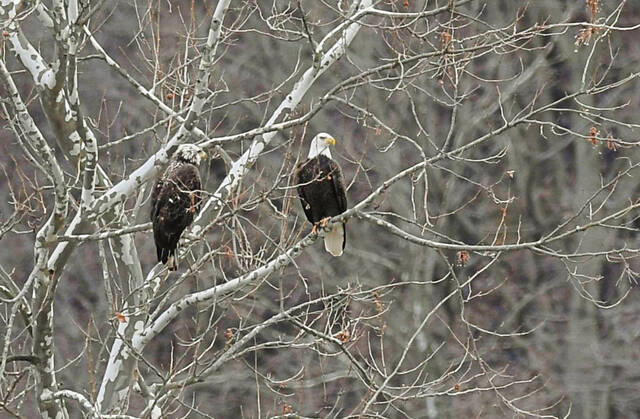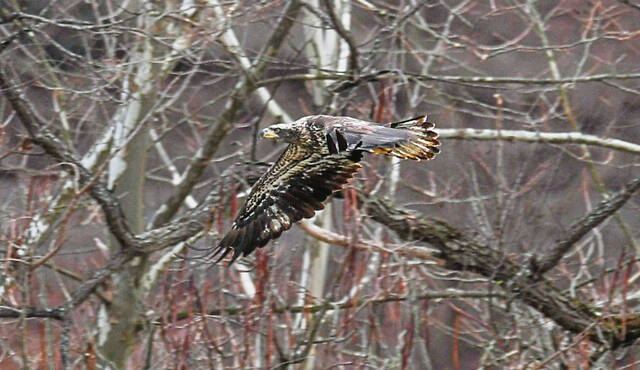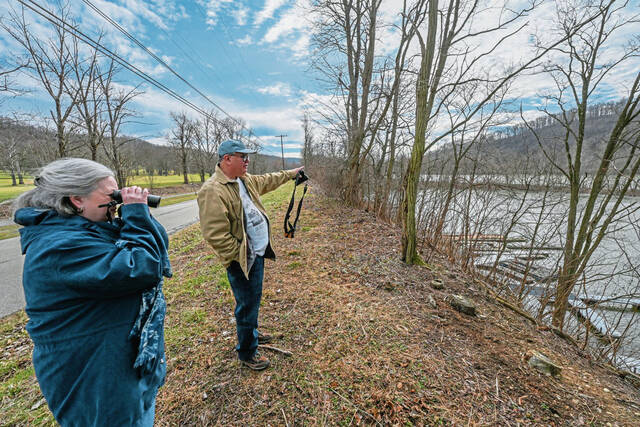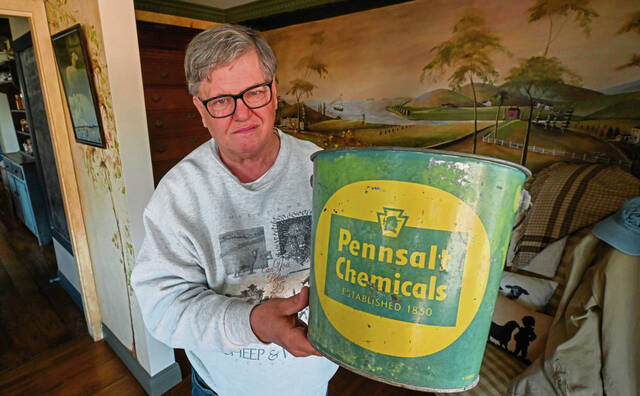Full circle: Bald eagles live, hunt near former Harrison DDT plant
About a decade ago, Audrey Krzeminski drove across the Freeport Bridge and saw construction workers pointing skyward. Out of nowhere, a mature bald eagle flew over her car, then — “thud!” — the bird accidentally dropped a fish on her hood.
“We almost ran into each other,” she said of her chance encounter. “Oh my God, each wing was as long as a yardstick.”
When she told her husband, Dave, he surmised the birds were living along the Allegheny River. The Allegheny Township couple has been watching multiple bald eagles on the Allegheny River near Freeport and River Forest ever since.
Dave Krzeminski, who grew up in Harrison, said: “These were the first eagles we saw readily. Everything has changed a lot. I didn’t see great blue herons as a kid, but I see them now.”
Going downriver several miles away in Natrona, artist and community activist Bill Godfrey picked up a small piece of litter near his manicured side yard with whimsical silver metal fish embedded in his sidewalk, and observed, “This small town changed the world for the good and the bad.
“Natrona almost single-handedly wiped out bald eagles and other birds with DDT,” Godfrey noted.
Now, bald eagles fly frequently near their former nemesis, a long-gone DDT production site at the former Pennsylvania Salt Manufacturing Co. in Natrona, founded in 1850.
DDT and the Alle-Kiski Valley
Penn Salt held at least one patent on a form of DDT. It produced the popular insecticide for at least a year at its Natrona plant and longer at other sites.
Three canisters — the size of a can of Comet cleanser — of residential DDT pesticide manufactured by Penn Salt sit in Godfrey’s studio destined for a new museum he is developing for the long-gone manufacturer that capitalized on salt wells and produced chemical products sold worldwide. It also built a small company town that is listed on the National Register of Historic Places.
After World War II, chemical companies such as Penn Salt rolled out advertising campaigns to sell DDT to consumers. A Penn Salt ad in Time Magazine in 1947 features an illustration of a housewife wearing a frilly apron next to a smiling cow, a dancing apple, along with a dog, potato and a rooster singing “DDT is good for me-e-e-e!” The miracle chemical was heralded for saving lives from malaria and zapping pesky insects from backyards, crops and just about everywhere else.
“The town prided itself on having no mosquitoes,” Godfrey said.
Just eight miles downstream from Godfrey’s studio is the childhood home of the biologist and world-renowned author Rachel Carson, who grew up in Springdale.
Carson’s book “Silent Spring” exposed the impact of DDT and other pesticides on eagles, robins and other birds around the world.
“It’s come full circle,” Godfrey said. The good: Penn Salt’s chemicals helped eliminate malaria and other insect-borne diseases as well as arresting the boll weevil epidemic that hit cotton plantations in the southern United States, he said.
“We saved the South’s economy, but we found out there were all kind of side effects. At the beginning, no one realized the harmful effects,” Godfrey said. “The DDT insecticide canisters were passed out to Penn Salt workers as Christmas bonuses,” he said.
Godfrey wants his upcoming Penn Salt museum to provide education on the company’s environmental impact. Godfrey’s nonprofit, Natrona Comes Together, has been offering classes to local youths for 18 years.
“It’s a learning situation. There are reactions from certain chemicals. If you can learn through history, you can make the future better. And that is why we are embracing it.”
Carson and DDT
Carson was born in 1907 and raised in Springdale. She left the area to pursue higher education. She had a career as a marine biologist for the U.S. Fish and Wildlife Service in addition to being an author.
Carson’s blend of scientific and poetic writing stirred the country with the release of “Silent Spring” in 1962, sounding an alarm about insecticides and chemicals killing birds around the globe.
The book is credited with launching the modern environmental movement, leading to the ban on DDT. It also led to the establishment of the federal Environmental Protection Agency and the federal Endangered Species Act, which protected and saved bird species such as the bald eagle.
The Allegheny River is a thread through that tightly woven history. After an absence of decades, bald eagles are an almost common sight in Harmar, near the Carson homestead and upstream in Natrona, Freeport and points north.
There have been three or more active nests in the Freeport area and upriver, according to Jim Bonner, a Tarentum resident and executive director of the Audubon Society of Western Pennsylvania.
“The eagles are very emblematic of the changes and evolution we have seen in the river valleys,” he said.
“The thought that DDT was produced here, and that Rachel Carson comes from this area and opened our eyes to the problems, mirrors the change of what happened to us — pollution, then recovery, and embracing a greener way.”
But the Allegheny River valley isn’t the only place locally that bald eagles call home.
In Westmoreland County, the raptors have been spotted regularly over the years in and around Loyalhanna Lake and Dam.
“Loyalhanna has some dedicated signage and viewing areas there with information on them,” said Alex Busato of Scottdale, president of the Westmoreland Bird & Nature Club.
“Other good locations I know of are along the Route 286 causeway over Beaver Run Reservoir — although there’s nowhere to really stop. Bridgeport Dam in Mt. Pleasant also had two or three each year, but they’re a bit harder to view since they are at the far end of the lake.”
The Hays bald eagles, living along the Monongahela River in Pittsburgh, were the first bald eagles to nest within the city’s limits in almost 100 years.
Remove the ads from your TribLIVE reading experience but still support the journalists who create the content with TribLIVE Ad-Free.


